As pretty as pastel snapdragons and periwinkle bluebells can be, sometimes gardeners crave something a bit different in their garden designs.
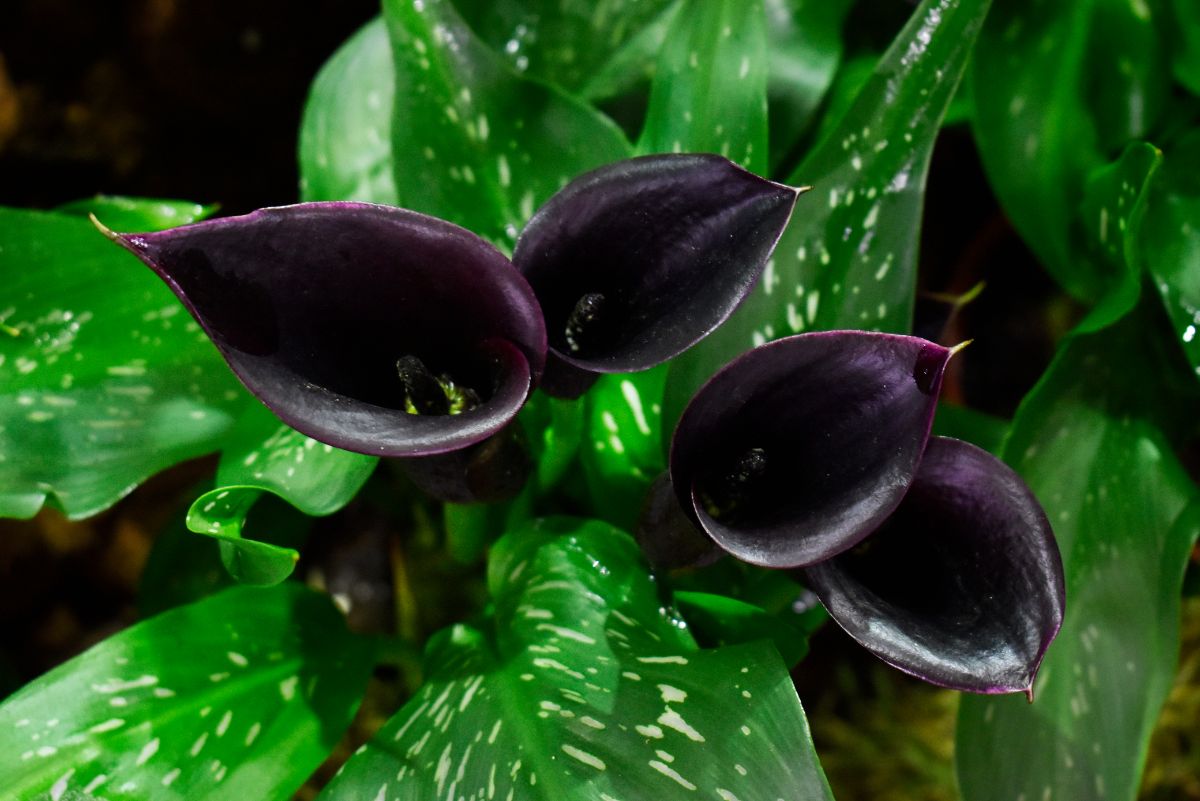
Themed gardens come in all styles and are becoming increasingly popular in the gardening world. From moon gardens planted with bright white flowers that dazzle in the moonlight to scent gardens redolent with the sweet aromas of heirloom roses and night-blooming jasmine, there are countless garden styles to choose from. And one particularly alluring garden variety is the dark or “gothic” garden.
This garden style may not be for everyone, but if you like an edgier feel or you want to accentuate your classic Victorian home, darker plants and flowers may be for you. In this guide, we’ll introduce you to a wide range of nearly black flowers and plants that will add drama and creative flair to any landscape design.
Jump to:
- 25 dark flowers and plants to add drama to your garden
- 1. ‘Onyx Odyssey’ Hellebore
- 2. ‘Molly Sanderson’ Viola
- 3. ‘Black Baccara’ Rose
- 4. ‘Sophistica Blackberry’ Petunia
- 5. ‘Black Beauty’ Elderberry
- 6. Black Mondo Grass
- 7. ‘Before the Storm’ Iris
- 8. ‘Queen of the Night’ Tulip
- 9. ‘Black Magic’ Elephant Ears
- 10. ‘Nigra’ Hollyhock
- 11. ‘Black Beauty’ Pansy
- 12. ‘Diabolo’ Ninebark
- 13. Zantedeschia ‘Black Star’
- 14. ‘Royal Purple’ Smoke Tree
- 15. ‘Red Rubin’ Basil
- 16. Tricolor Beech
- 17. Black Coral Bells
- 18. ‘Black Pearl’ Pepper
- 19. ‘Zwartkop’ Aeonium
- 20. ‘Black Swan’ Weeping Beech
- 21. ‘Blackie’ Sweet Potato Vine
- 22. ‘Dark Dimension’ Hyacinth
- 23. ‘Black Barlow’ Columbine
- 24. ‘Black Prince’ Coleus
- 25. Purple Plum Tree
- Frequently asked questions
- Summary
25 dark flowers and plants to add drama to your garden

From tall trees to petite blooms perfect for planters, there are lots of dark flowers and plants to choose from. Below, we’ll introduce you to our top 25 favorite dark plants for window boxes, inground beds, and other ornamental designs.
1. ‘Onyx Odyssey’ Hellebore
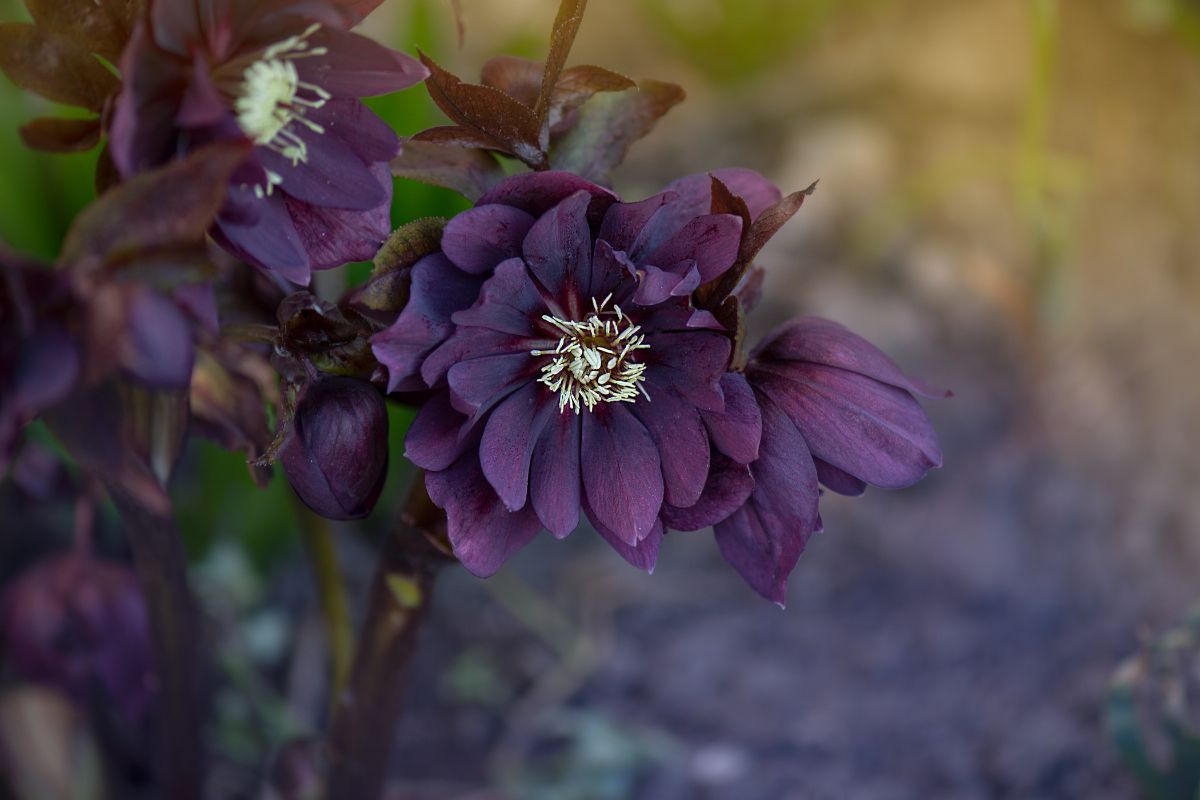
| Plant name: | ‘Onyx Odyssey’ Hellebore |
| Light requirements: | Sun to shade, part sun preferred |
| Watering requirements: | Moderate |
| Notable features: | Early bloomer; pollinator favorite |
| Growing zone: | Zones 4 to 9 |
Also known as Lenten Roses for their bloom time, hellebores flower in early spring, long before most other flowering plants. This makes hellebores a good choice for pollinator gardens, as they provide food for early emerging pollinators. These colorful plants come in a wide range of hues, but ‘Onyx Odyssey’ is a lovely dark hellebore choice.
This cultivar has such dark flowers that they appear almost black, which can look even more eye-catching when they bloom through the snow! Cup-shaped flowers feature double blooms and make wonderful cut flowers too. Just keep in mind these plants are toxic to cats and dogs.
2. ‘Molly Sanderson’ Viola

| Plant name: | ‘Molly Sanderson’ Viola |
| Light requirements: | Full sun to part shade |
| Watering requirements: | Moderate |
| Notable features: | Early bloomer; cold weather hardy; easy to grow |
| Growing zone: | Zones 3 to 8 |
Violas are very easy to grow plants, and they’re small space friendly. Sprouting quickly from seed, these plants only grow a few inches tall and can easily be kept in container planters. But if you’re on the hunt for a dark bloom to accent your gothic Victorian window boxes, ‘Molly Sanderson’ is the cultivar to look for.
‘Molly Sanderson’ has dark purple, near-black petals that are soft to the touch and make pretty pressed flowers too. Like other violas, ‘Molly Sanderson’ is cold hardy, and can bloom from early summer through fall.
3. ‘Black Baccara’ Rose
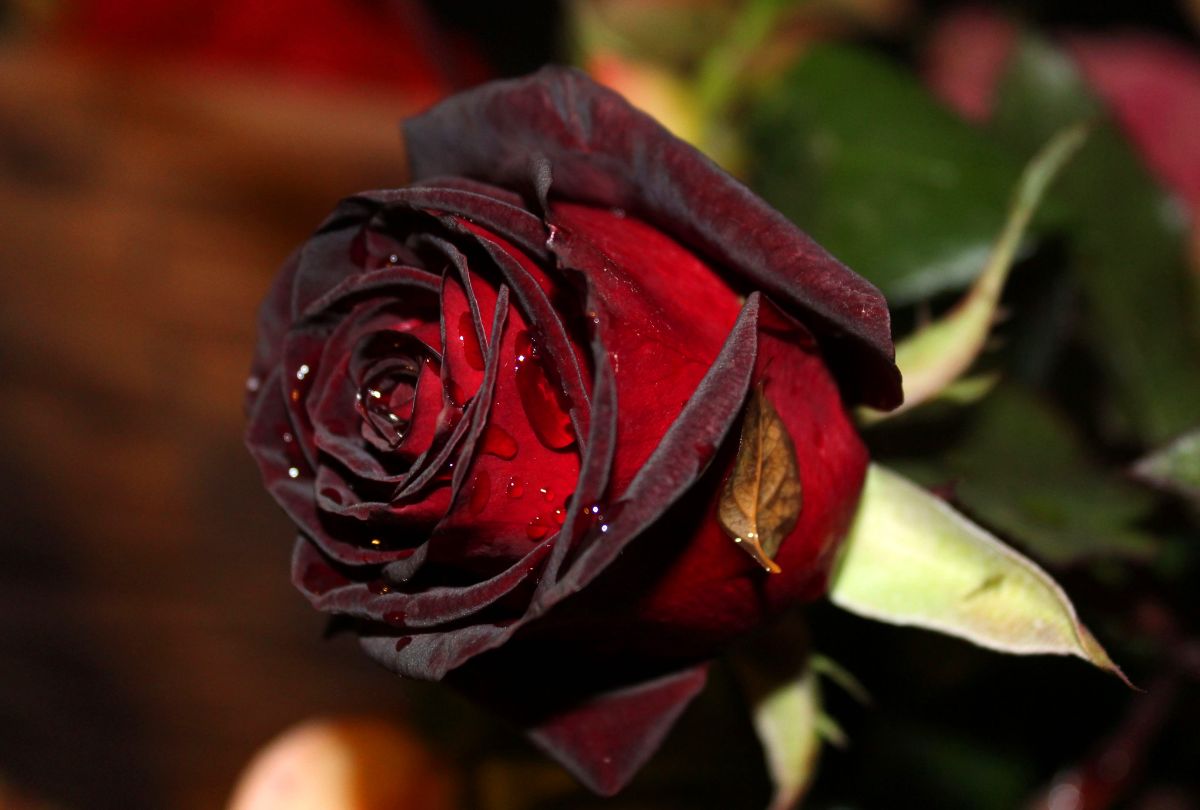
| Plant name: | ‘Black Baccara’ Rose |
| Light requirements: | Full sun |
| Watering requirements: | Moderate |
| Notable features: | Excellent cut flowers; attracts butterflies |
| Growing zone: | Zones 6 and up |
‘Black Baccara’ is a hybrid tea rose with gorgeous, velvety petals in a deep crimson hue. Flowers are large, measuring about 3” across, and have a dusky color to them. These roses are elegant when planted near other dark plants, like the ‘Black Beauty’ elderberry.
Bushes grow up to 6’ high, while flowers appear on the tips of long and sturdy stems that are ideal for cut flowers. ‘Black Baccara’ blooms in flushes from spring through fall.
4. ‘Sophistica Blackberry’ Petunia
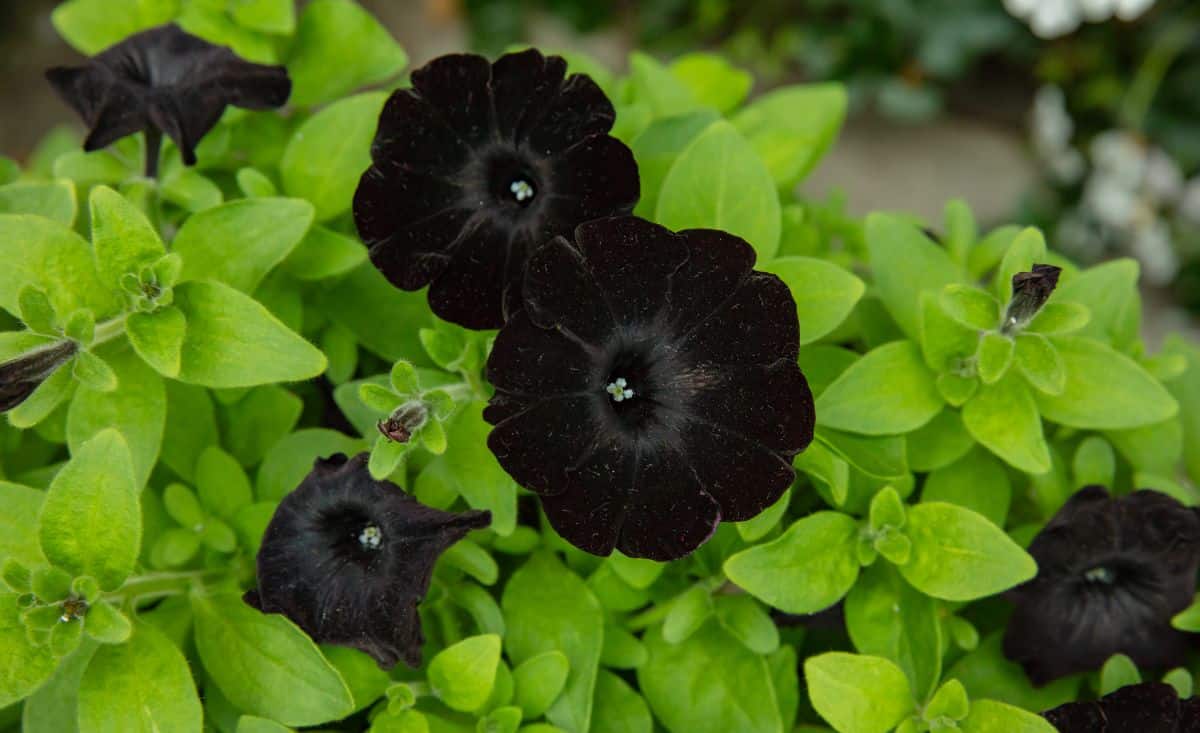
| Plant name: | ‘Sophistica Blackberry’ Petunia |
| Light requirements: | Full sun |
| Watering requirements: | High to moderate |
| Notable features: | Cold weather hardy; good for hanging baskets |
| Growing zone: | Zones 9 to 11; grown as annuals in cooler locations |
Like violas, petunias are low-maintenance plants that are cool weather hardy and can bloom from spring through fall. While they are often planted in containers and inground beds, petunias’ sweeping foliage is well adapted to hanging baskets as well.
While there are lots of different petunia varieties to choose from, if you’re looking for darkly colored plants, ‘Sophistica Blackberry’ is at the top of the list. This abundant bloomer has deep crimson petals that look nearly black in lower light.
5. ‘Black Beauty’ Elderberry

| Plant name: | ‘Black Beauty’ Elderberry |
| Light requirements: | Full sun to part shade |
| Watering requirements: | Moderate |
| Notable features: | Edible fruit; attracts birds |
| Growing zone: | Zones 3 to 7 |
For a larger impact in your garden, ‘Black Beauty’ elderberry can be a great choice, as this plant grows large – maxing out at around 12’ high. While gardeners are usually familiar with elderberries, this sophisticated cultivar has richly hued, dark purple leaves for even more flair. In early summer, ‘Black Beauty’ blooms large, foamy flowers that are colored in pink and white.
As with other elderberries, this variety produces edible fruit that can be turned into syrups and other recipes. Berries are also a hit with wild birds, making this plant a good choice for pollinator gardens.
6. Black Mondo Grass
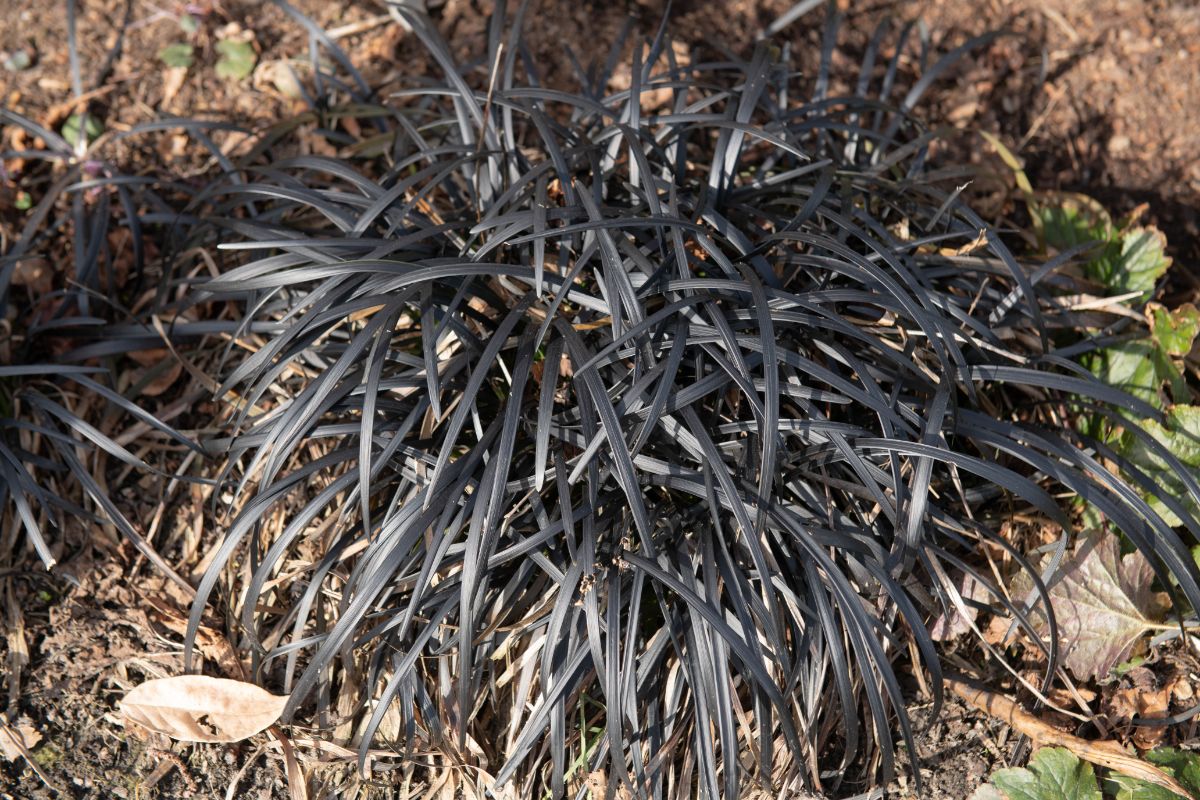
| Plant name: | Black Mondo Grass |
| Light requirements: | Full sun to part shade |
| Watering requirements: | Moderate |
| Notable features: | Excellent border plant |
| Growing zone: | Zones 5 to 10 |
A perfect accent plant, black Mondo grass is hard to beat when it comes to filling in garden beds and adding striking borders along outdoor walkways. This perennial plant grows 5 to 6” high and develops dark, purplish-black leaves that are grass-like in form and arch gently toward the plant’s base.
In summer, black Mondo grass gets even more colorful when it blooms small, purple flowers that mature into purple berries in autumn. A slow grower, this plant forms mounds as it spreads, but it is appropriate for container planting too.
7. ‘Before the Storm’ Iris
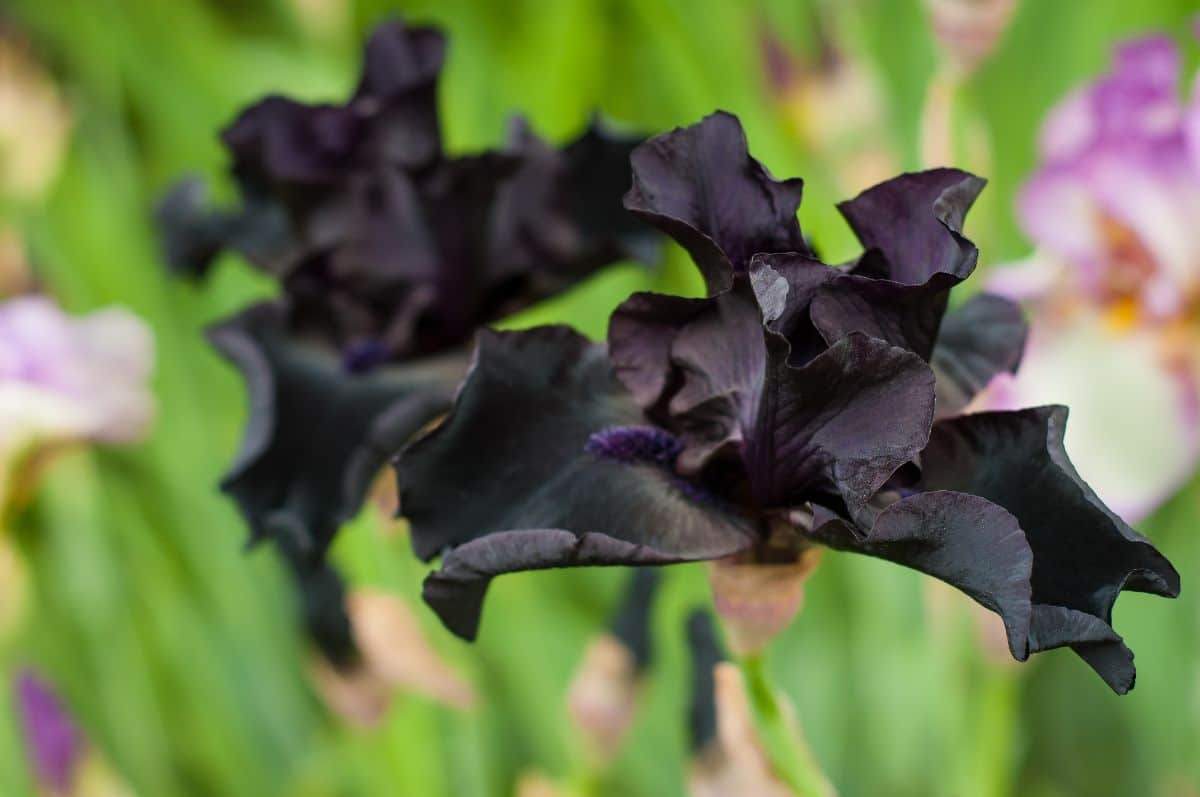
| Plant name: | ‘Before the Storm’ Iris |
| Light requirements: | Full sun |
| Watering requirements: | Moderate |
| Notable features: | Excellent cut flowers |
| Growing zone: | Zones 5 to 9 |
A variety of tall, bearded iris, ‘Before the Storm’ features dark purple, near black petals that have delightfully ruffled edges. While flowers look very pretty in garden spaces, they also work well as cut flowers if you’re interested in flower arranging. Once mature, these plants grow to about 37” high and may exude a subtle, sweet fragrance when in bloom.
As with other iris varieties, ‘Before the Storm’ will bloom in late spring to early summer. Bulbs should be divided every 3 to 5 years from July to mid-August to keep plants from getting overcrowded.
8. ‘Queen of the Night’ Tulip
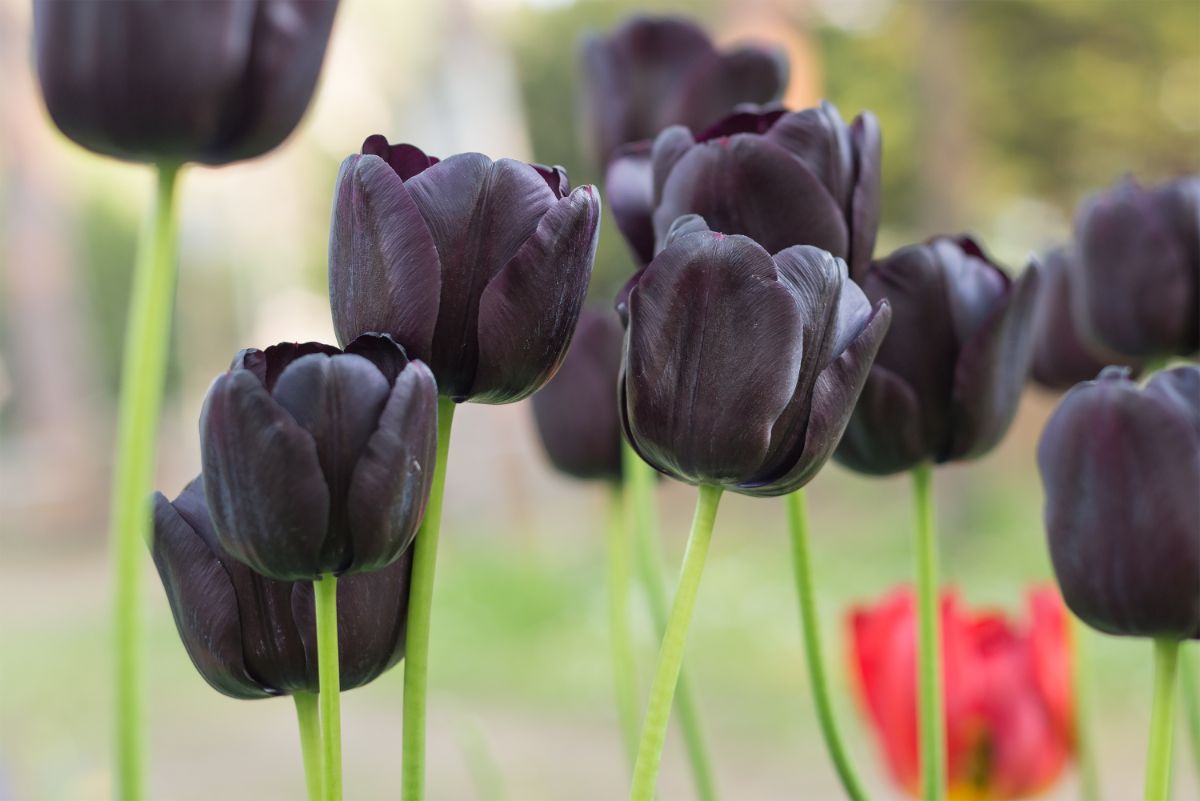
| Plant name: | ‘Queen of the Night’ Tulip |
| Light requirements: | Full sun |
| Watering requirements: | Moderate to low |
| Notable features: | Excellent cut flowers; early bloomer |
| Growing zone: | Zones 3 to 7 |
Tulips are showstopping plants as it is, but ‘Queen of the Night’ takes the drama even further! These gorgeous flowers have velvety, deep purple petals that are so dark they appear black. While they look stunning on their own, ‘Queen of the Night’ is even more spectacular when interplanted with white tulips for a moon garden display.
Like other tulips, plant bulbs in autumn for late spring blooms.
9. ‘Black Magic’ Elephant Ears
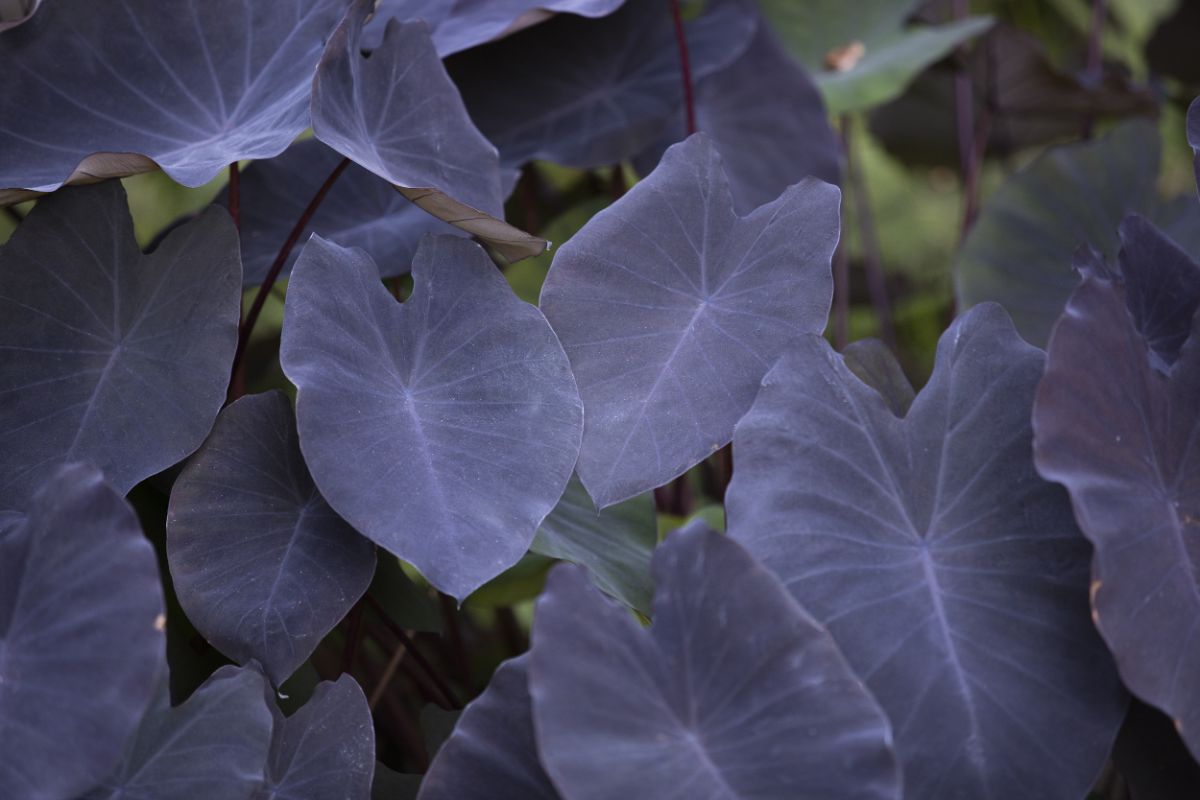
| Plant name: | ‘Black Magic’ Elephant Ears |
| Light requirements: | Full sun to part shade |
| Watering requirements: | High to moderate |
| Notable features: | Easy to grow |
| Growing zone: | Zones 8 to 10; can be overwintered indoors in cooler locations |
Elephant ears can be grown indoors or out and are pretty easygoing plants. ‘Black Magic’ is a very attractive variety that grows to about 6’ in height and can be planted in garden beds or containers. Like other elephant ears, this cultivar grows massive leaves that are about 2 to 3’ long, although these leaves are dark and almost velvet-like in appearance.
A warm weather-loving plant, ‘Black Magic’ is only hardy down to zone 8. While it can be kept as an annual in cooler locations, gardeners often dig up tubers in autumn and overwinter them indoors until spring.
10. ‘Nigra’ Hollyhock
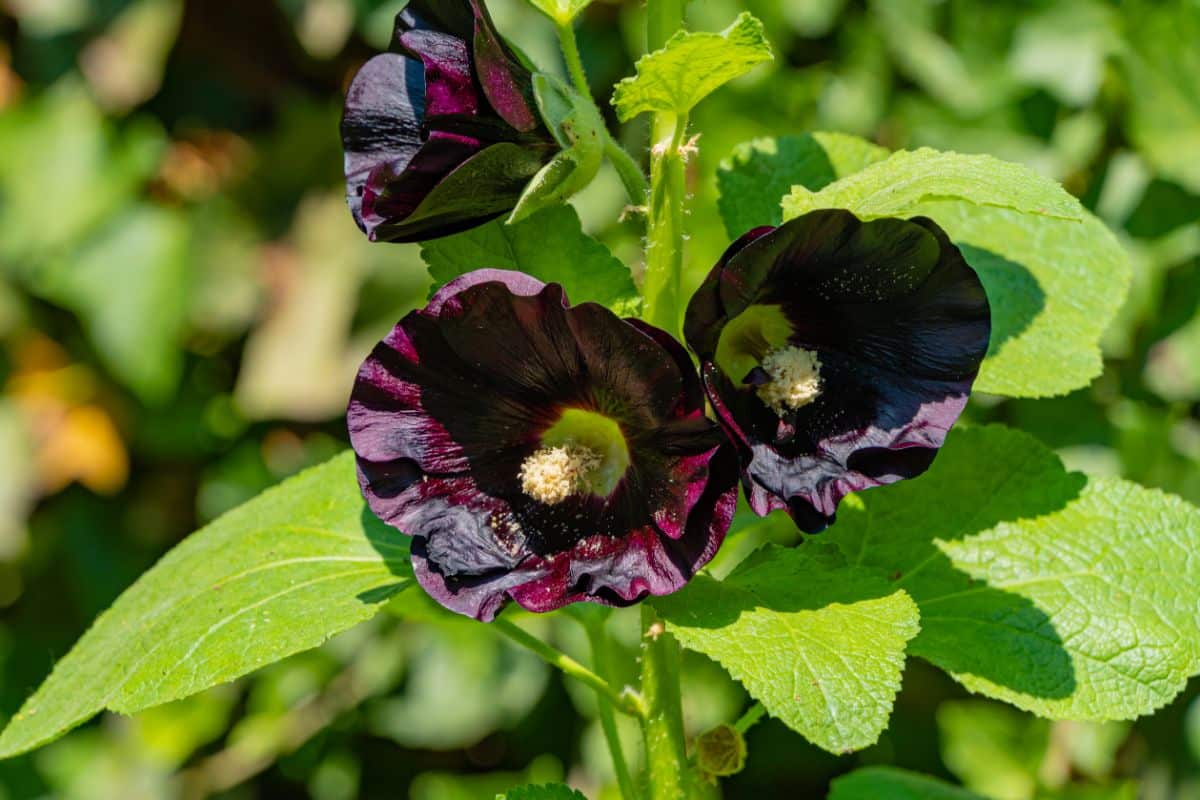
| Plant name: | ‘Nigra’ Hollyhock |
| Light requirements: | Full sun |
| Watering requirements: | Moderate to low |
| Notable features: | Easy to grow; pollinator favorite |
| Growing zone: | Zones 3 to 8 |
Hollyhocks are biennials, so they may not bloom until the second year, but they’re worth the wait! These easy-to-grow plants are usually started from seed, which can be sown indoors in spring or directly sown outdoors too. Sometimes, if you plant seeds early enough, you may even be able to get flowers the first year.
‘Nigra’ hollyhock is a popular cultivar with deep purple petals. Grown for centuries, this heirloom hollyhock has a bit of history to it, and it's popular with bees and other pollinators. Like other hollyhocks, ‘Nigra’ grows best in full sun.
11. ‘Black Beauty’ Pansy
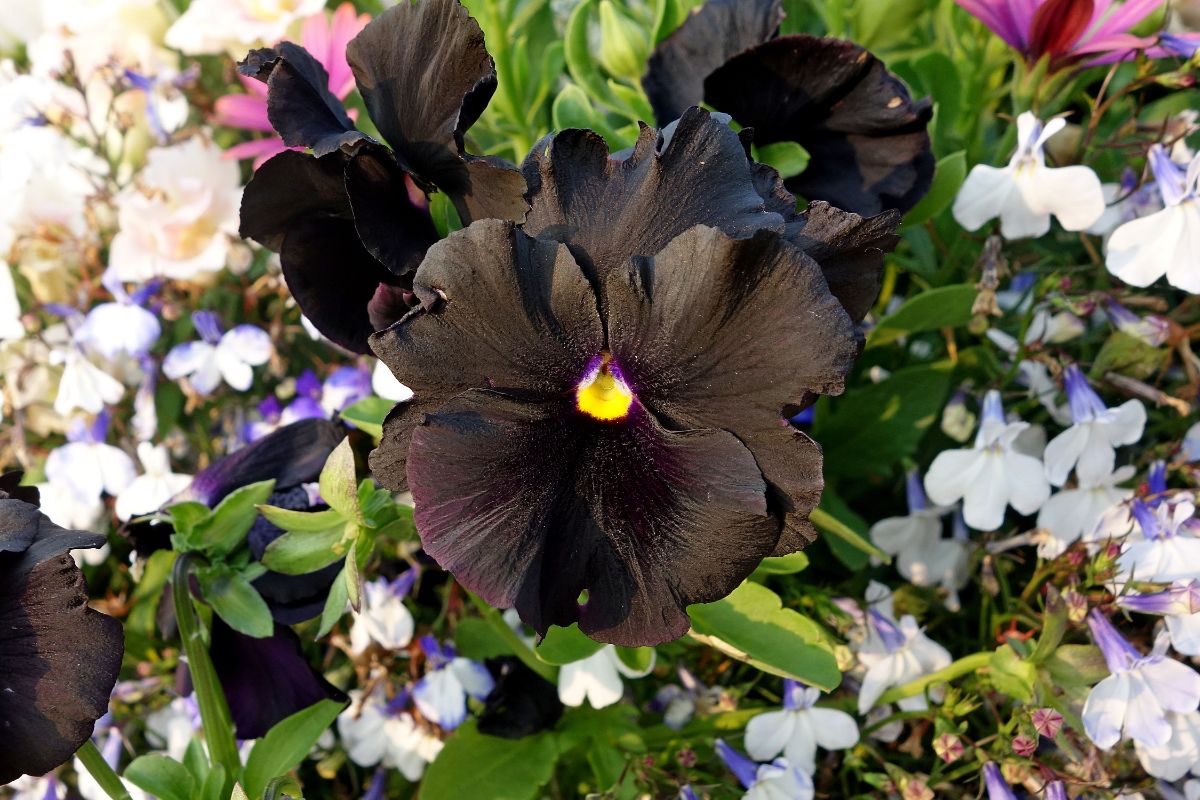
| Plant name: | ‘Black Beauty’ Pansy |
| Light requirements: | Full sun to part shade |
| Watering requirements: | Moderate |
| Notable features: | Early bloomer; cold weather hardy |
| Growing zone: | Zones 7 to 10; grown as annuals in cooler locations |
Pansies look a lot like violas, but flower heads are generally a bit bigger. For gardeners who love darkly colored beds, ‘Black Beauty’ is a classic choice. Try this plant on its own or pair it with ‘Molly Sanderson’ violas to create a playful arrangement of differently sized and textured blooms.
As with violas, pansies are cool weather hardy, and they can bloom from spring until the frosts of fall. These compact plants also thrive in containers and hanging baskets and make delicate border plants for inground beds as well.
12. ‘Diabolo’ Ninebark

| Plant name: | ‘Diabolo’ Ninebark |
| Light requirements: | Sun to shade |
| Watering requirements: | Moderate to low |
| Notable features: | Drought tolerant once established |
| Growing zone: | Zones 3 to 7 |
This deciduous shrub has dark, brownish-purple leaves and white flowers that bloom in clusters during the summer. Growing between 8 and 10’ high, ‘Diabolo’ makes an excellent specimen shrub when planted on its own, but it works well as a privacy hedge too if you want to group a few of them together.
Like other ninebarks, ‘Diabolo’ can handle the heat and is relatively drought resistant. That said, leaves may turn greener in hot weather or partial shade, so make sure your plant gets enough sun to support its dark, leafy growth.
13. Zantedeschia ‘Black Star’
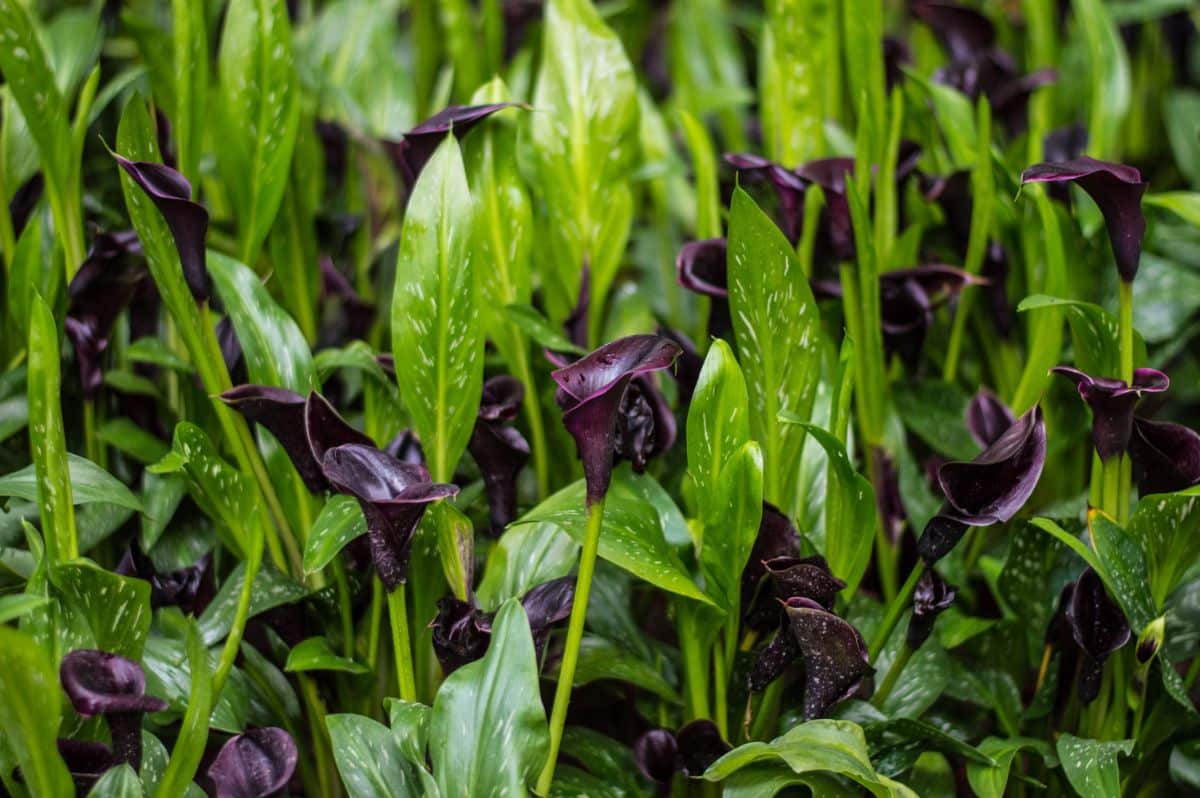
| Plant name: | Zantedeschia ‘Black Star’ |
| Light requirements: | Full sun to part shade |
| Watering requirements: | Moderate |
| Notable features: | Excellent cut flowers |
| Growing zone: | Zones 9 to 11; can be overwintered indoors in cooler locations |
A type of calla lily, ‘Black Star’, is ornamented with speckled leaves and large, chalice-shaped blooms in a crimson so deep they look black. A warm weather plant, ‘Black Star’ is only hardy to zone 7, but it can be kept as an annual in cooler locations. Rhizomes can also be dug in autumn and overwintered indoors if you want to keep your flowers coming back.
‘Black Star’ may not sprout until May, but flowers come quickly and bloom in abundance in June. These plants are just the right size for container planters and inground beds.
14. ‘Royal Purple’ Smoke Tree
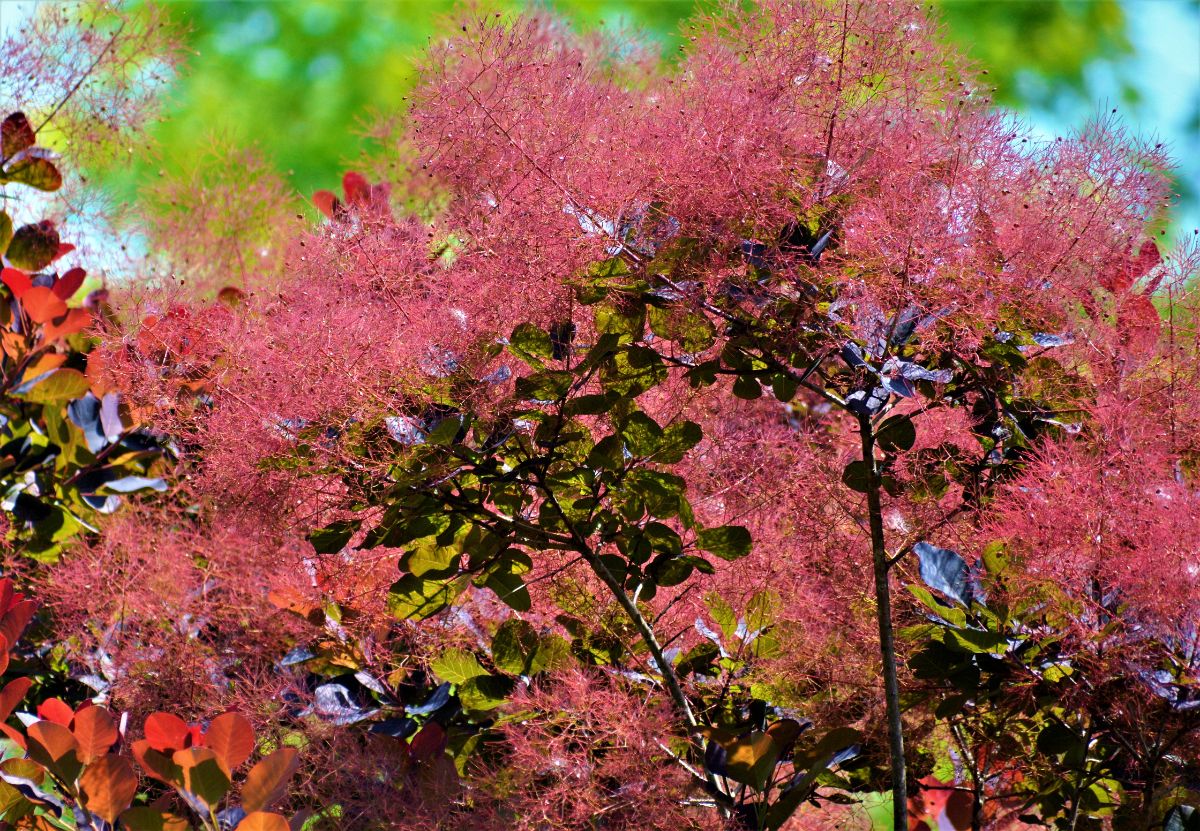
| Plant name: | ‘Royal Purple’ Smoke Tree |
| Light requirements: | Full sun to part shade |
| Watering requirements: | Moderate to low |
| Notable features: | Colorful specimen tree; drought tolerant once established |
| Growing zone: | Zones 5 to 9 |
Smoke trees are always dramatic-looking plants, and ‘Royal Purple’ doesn’t disappoint. This dark accent shrub features purplish-green, rounded foliage that’s adorned with sprays of foamy, crimson blooms. Flowers emerge in summer and are long-lasting for lots of garden color.
Smoke trees prefer deep watering and full sun, but they are adaptable enough to tolerate even poor soils. Try planting ‘Royal Purple’ with ‘Diabolo’ ninebark for a garden display that is certain to impress the neighbors.
15. ‘Red Rubin’ Basil
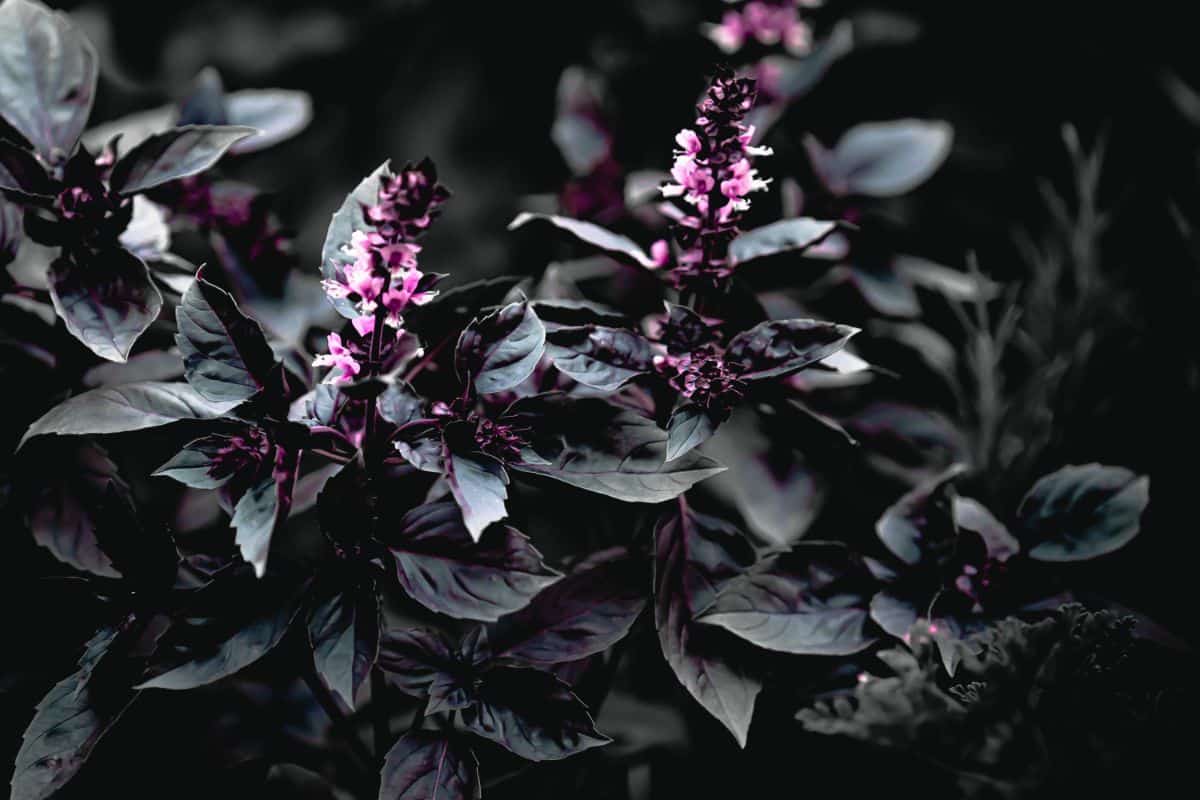
| Plant name: | ‘Red Rubin’ Basil |
| Light requirements: | Full sun |
| Watering requirements: | Moderate |
| Notable features: | Edible; easy to grow |
| Growing zone: | Zones 11 and above; grown as annuals in cooler locations |
Basil is usually thought of as an edible herb, but if you’re working with colorful varieties like ‘Red Rubin,’ basil can also work as an ornamental! ‘Red Rubin’ has the same growing requirements as common basil; just give it plenty of water and sun and keep it shaded from too much bright light. You can use this variety for recipes too, or allow it to flower for a showier look.
Adaptable to inground gardens and containers, ‘Red Rubin’ makes a fine accent plant and filler in planting arrangements.
16. Tricolor Beech
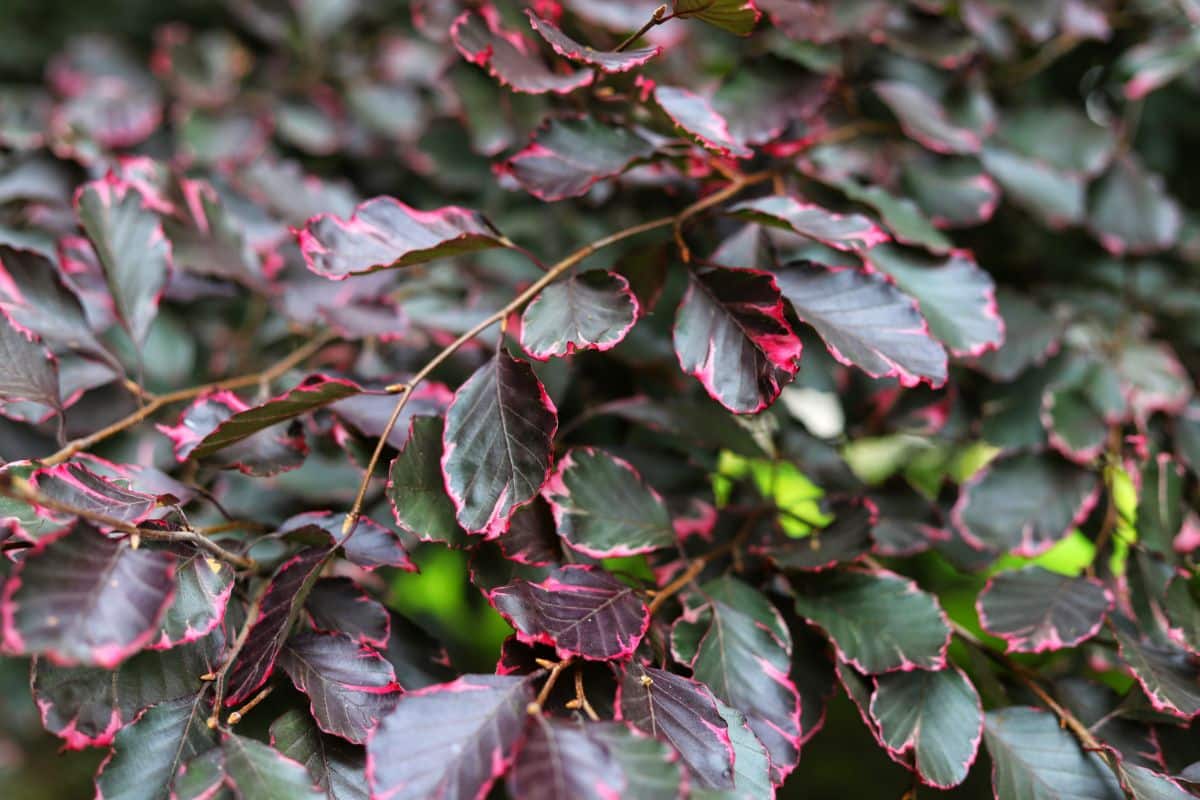
| Plant name: | Tricolor Beech |
| Light requirements: | Shade |
| Watering requirements: | Moderate |
| Notable features: | Colorful specimen tree |
| Growing zone: | Zones 4 to 7 |
Tricolor beech may not be a black plant, but it has highly variegated leaves that add depth and contrast to any landscape design. Slightly wavy, oval leaves measure about 4” long and are highly patterned in a dusky brown and fuchsia coloring. Growing up to 40’ high, this colorful tree can create an exceptional backdrop to gothic garden designs and other darker planting arrangements.
Hardy to zone 4, tricolor beeches prefer rich, well-draining soil, and they can grow in partial shade too!
17. Black Coral Bells
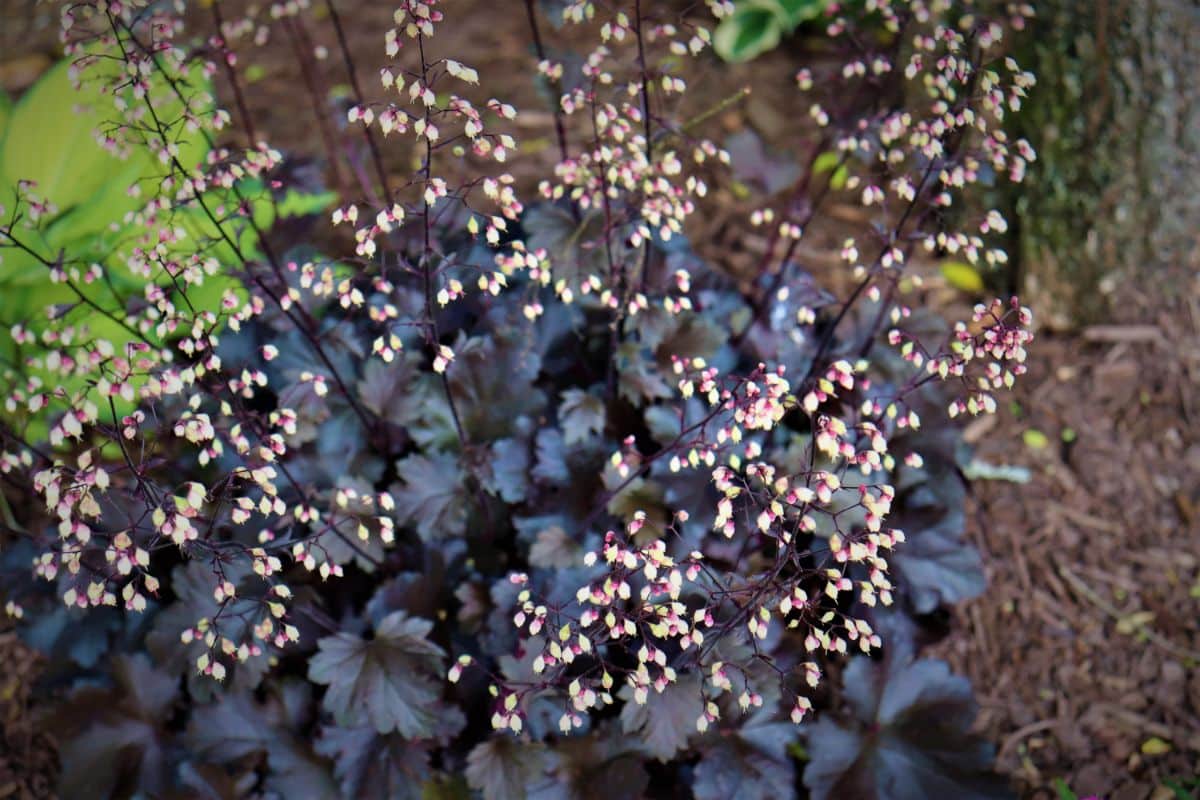
| Plant name: | Black Coral Bells |
| Light requirements: | Sun to shade |
| Watering requirements: | Moderate |
| Notable features: | Easy to grow; deer resistant |
| Growing zone: | Zones 4 to 9 |
Coral bells are well known for their colorful leaves, which come in a range of hues, including green, gold, and, of course, black! As low-growing, mounding plants, coral bells are often planted in containers, but they work as border plants and fillers in garden beds as well. In mid-summer, these plants get even showier when they bloom white flowers atop pink calyxes.
Coral bells can grow in full sun to shade, and they can even tolerate some salt, so they can be planted near roadways. They are also mostly resistant to deer and are popular among pollinators!
18. ‘Black Pearl’ Pepper

| Plant name: | ‘Black Pearl’ Pepper |
| Light requirements: | Full sun |
| Watering requirements: | Moderate |
| Notable features: | Edible |
| Growing zone: | Zones 9 to 11; grown as annuals in cooler locations |
‘Black Pearl’ is a funky-looking plant with nearly black leaves and glossy, globular peppers that look like tiny pearls. And don’t worry; those peppers are completely edible if you want to munch on them. Just keep in mind these fiery plants are spicy, with a Scoville rating of 10,000 to 30,000 SHU (jalapenos have a SHU of around 2,000 to 8,000 for reference).
While ‘Black Pearls’ can be grown in your vegetable garden, they are often used as accent plants in container arrangements. Try planting ‘Black Pearls’ with ornamental grasses to create an interesting display that showcases plant texture and form.
19. ‘Zwartkop’ Aeonium
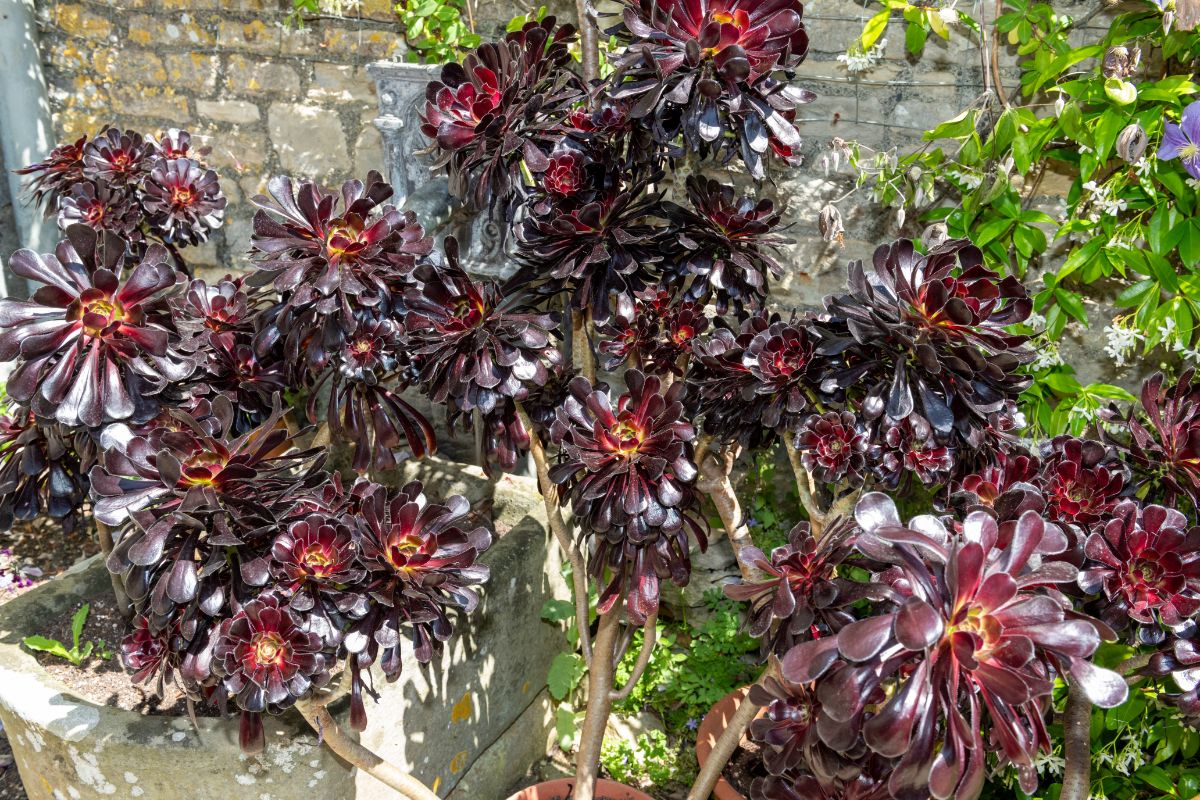
| Plant name: | ‘Zwartkop’ Aeonium |
| Light requirements: | Full sun to part shade |
| Watering requirements: | Low |
| Notable features: | Drought resistant |
| Growing zone: | Zones 9 to 11 |
If you live in a drier climate, many of the plants on this list may not work for you, as they require regular watering. But not ‘Zwartkop’ aeonium! Maintained as a short shrub, ‘Zwartkop’ grows between 3 and 4’ high and features rosettes of deep crimson leaves.
This desert-dwelling succulent requires minimal watering and is very easy to grow. Hardy to zone 9, ‘Zwartkop’ can also be overwintered indoors or even kept as a houseplant.
20. ‘Black Swan’ Weeping Beech
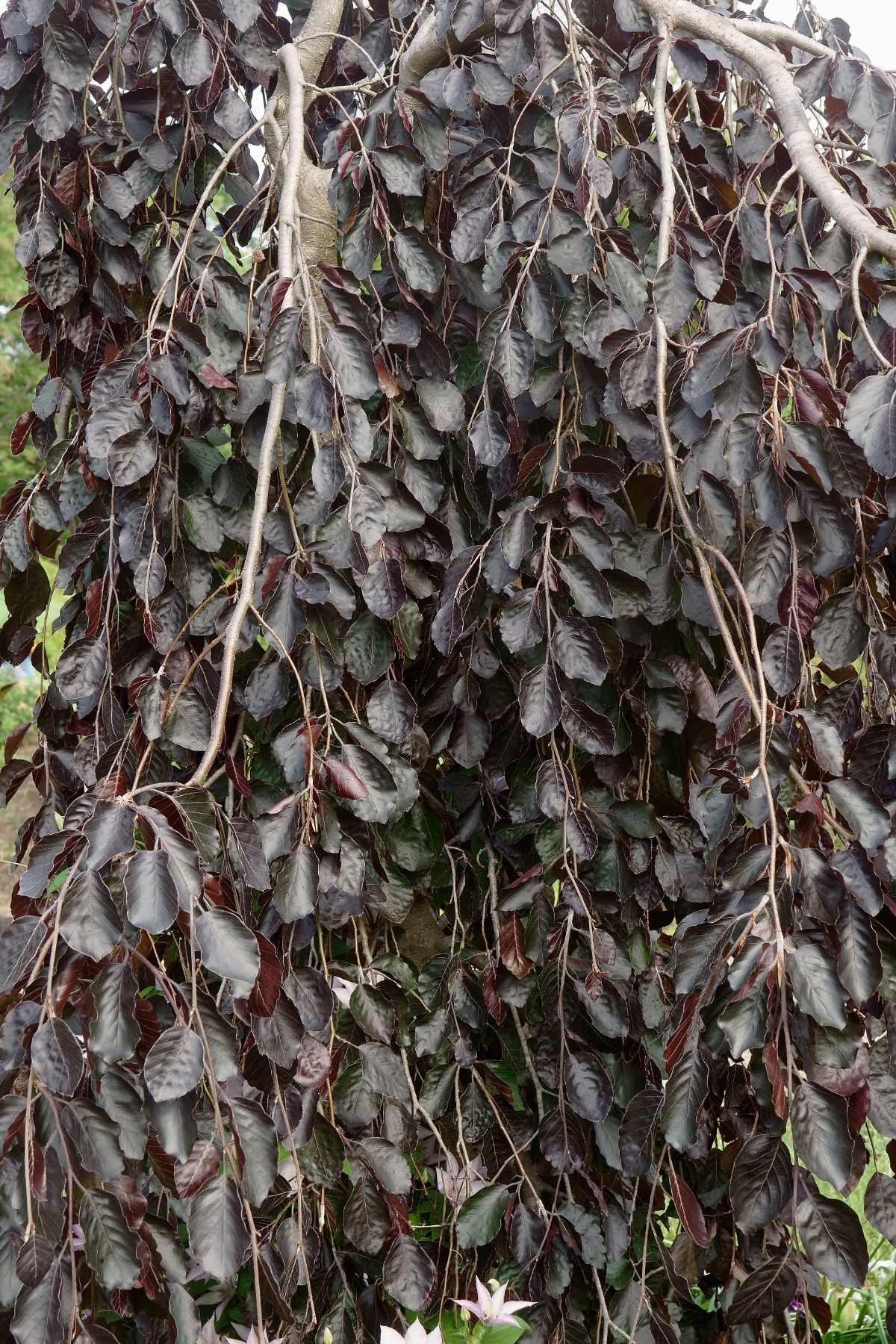
| Plant name: | ‘Black Swan’ Weeping Beech |
| Light requirements: | Full sun to part shade |
| Watering requirements: | Moderate |
| Notable features: | Structural specimen tree |
| Growing zone: | Zones 4 to 7 |
Weeping beeches have highly structural forms with long and cascading branches that move delicately in the breeze. ‘Black Swan’ is one particularly popular variety, known for its nearly black foliage. While leaves are coppery when they first emerge, they turn into a deep, greenish-purple as the season progresses.
An exceptional specimen tree, weeping beeches grow about 20’ high and can tolerate full sun to part shade.
21. ‘Blackie’ Sweet Potato Vine

| Plant name: | ‘Blackie’ Sweet Potato Vine |
| Light requirements: | Sun to shade |
| Watering requirements: | Moderate |
| Notable features: | Excellent container plant; edible tubers |
| Growing zone: | Zones 9 to 11; grown as annuals in cooler locations |
Sweet potato vines are commonly used as “spiller” elements in container plantings, as their long vines trail easily beyond pot sides and add lots of texture. While these plants come in different colors, if you’re looking for darker leaves, the ‘Blackie’ sweet potato vine has deep purple foliage, which is sure to please.
As tender perennial plants, sweet potato vines can come back year after year in zones 9 to 11. In cooler areas, vines are usually grown as annuals, but they can also be kept as houseplants. Additionally, these plants will grow edible sweet potato tubers, although they are not as productive as other sweet potato varieties.
22. ‘Dark Dimension’ Hyacinth
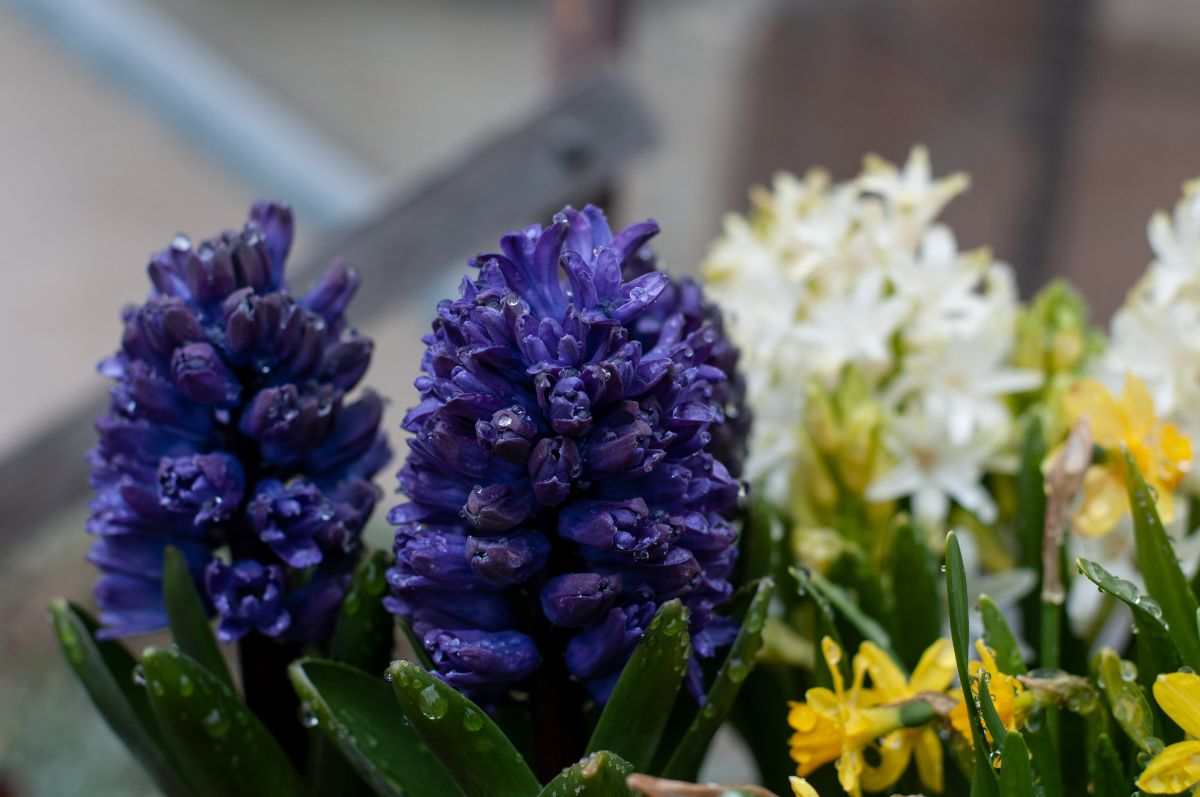
| Plant name: | ‘Dark Dimension’ Hyacinth |
| Light requirements: | Full sun to part shade |
| Watering requirements: | Moderate to low |
| Notable features: | Early bloomer; highly fragranced |
| Growing zone: | Zones 4 to 8 |
Hyacinths are cheery springtime bloomers with clusters of strongly scented flowers that appear along tall, vertical spires. While you’ll usually find hyacinths in pastel pinks and blues, if you crave an edgier aesthetic, ‘Dark Dimension’ is the hyacinth for you! This flower’s petals are technically a deep purple, but they’re so dark they look black in garden beds.
Like other hyacinths, bulbs are planted in the fall for springtime blooms. To get the most out of these flowers, try planting them near your door or in window boxes by an open window so you can smell the delicious floral fragrance!
23. ‘Black Barlow’ Columbine
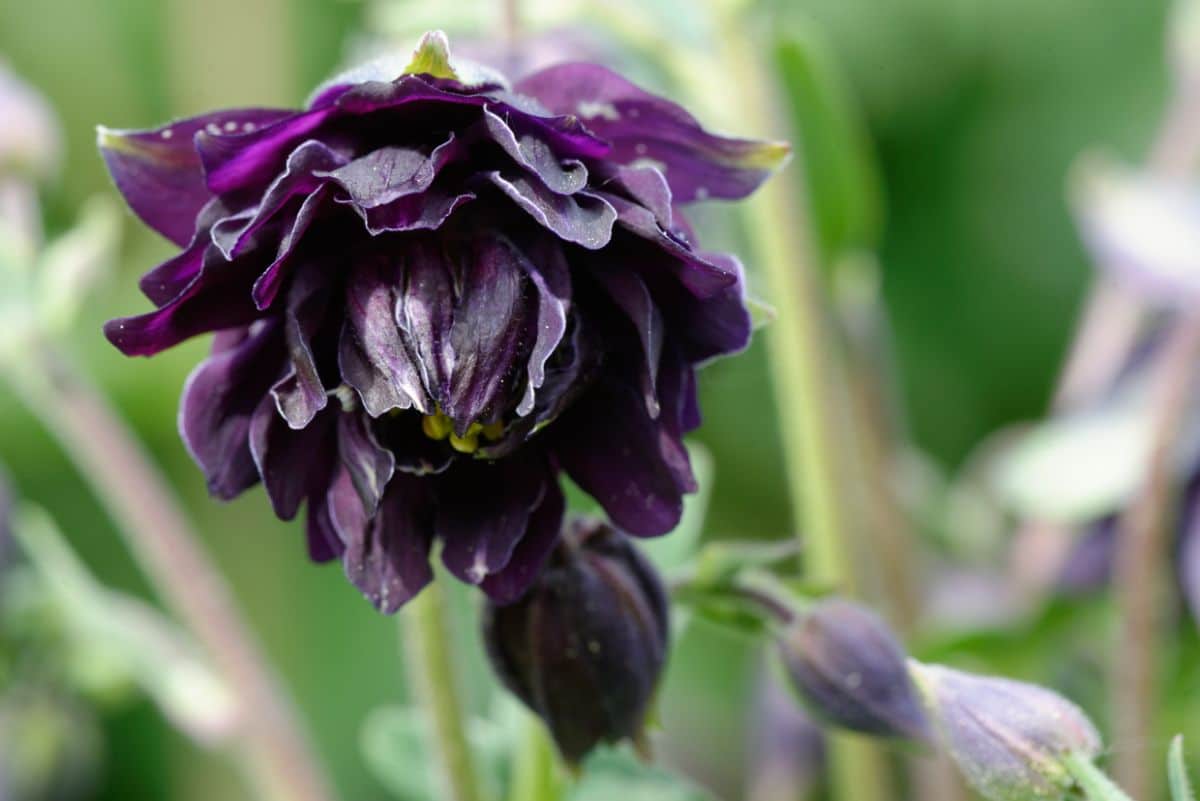
| Plant name: | ‘Black Barlow’ Columbine |
| Light requirements: | Full sun to part shade |
| Watering requirements: | Moderate |
| Notable features: | Excellent cut flowers |
| Growing zone: | Zones 3 to 9 |
Originally developed for cut flower arrangements, ‘Black Barlow’ has dark plum petals and downward-facing, double blooms. The airy feel of this plant is only accentuated by its delicate and fern-like foliage that moves gracefully in even the slightest breeze. Plants will usually produce about 3 to 5 flower stems in the first year but will grow more stems as plants age.
Like other columbines, ‘Black Barlow’ is sure to attract pollinators, like bees and butterflies. Naturally deer and rabbit resistant, this plant grows best in moist, well-draining soil and can adapt to sun or shade.
24. ‘Black Prince’ Coleus
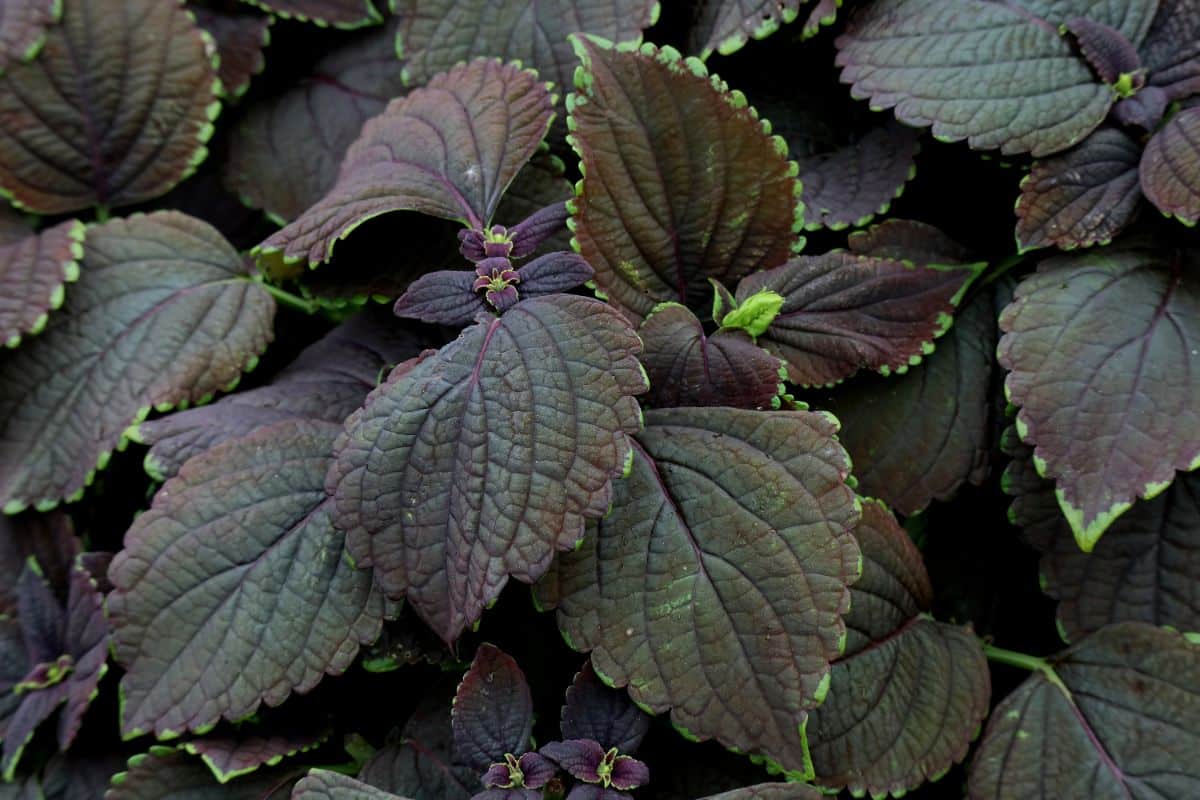
| Plant name: | ‘Black Prince’ Coleus |
| Light requirements: | Full sun to part shade |
| Watering requirements: | Moderate |
| Notable features: | Excellent container plant; easy to grow |
| Growing zone: | Zones 10 to 11; grown as annuals in cooler locations |
Coleus are some of the most popular filler plants for container arrangements, and it’s no wonder why. These colorful plants have leaves that come in a rainbow of hues, and they’re very adaptable. In fact, coleus can be grown as houseplants, and they can thrive in inground beds too!
‘Black Prince’ is one unique variety of coleus that has uniformly colored, dark purple leaves with scalloped margins. Adaptable to sun and shade, this plant maxes out at around 2 ½’ high and is heat tolerant as well.
25. Purple Plum Tree
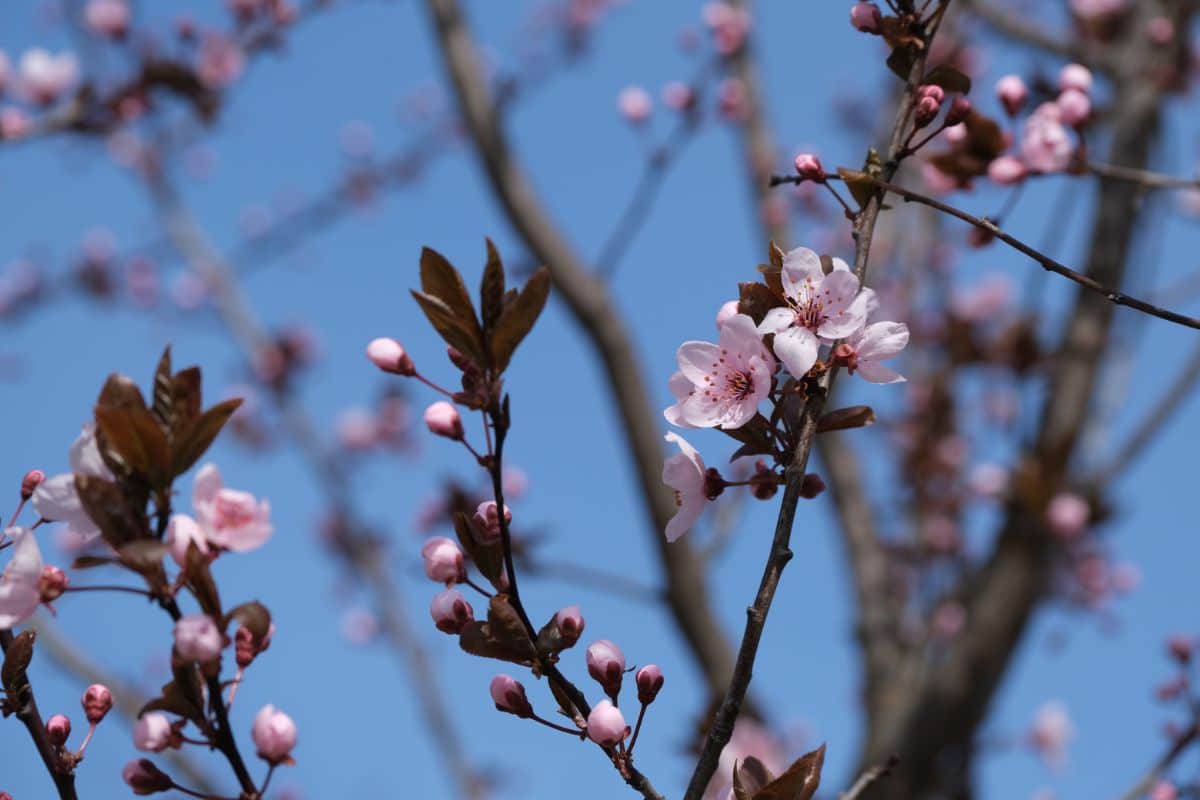
| Plant name: | Purple Plum Tree |
| Light requirements: | Full sun to part shade |
| Watering requirements: | Moderate |
| Notable features: | Colorful specimen tree; attracts birds |
| Growing zone: | Zones 4 to 9 |
Another darkly colored specimen tree, the purple plum tree, has deep purple leaves with a coppery sheen. Also known as flowering plum trees and cherry plum trees, these trees bloom a profusion of bright pink flowers in spring before deepening into their characteristic dark look.
Highly adaptable, purple plum trees can grow in shade or sun, and they can handle some drought too. Mature trees grow to about 25’ in height and are irresistible to birds and other pollinators when the fragrant flowers bloom.
Frequently asked questions
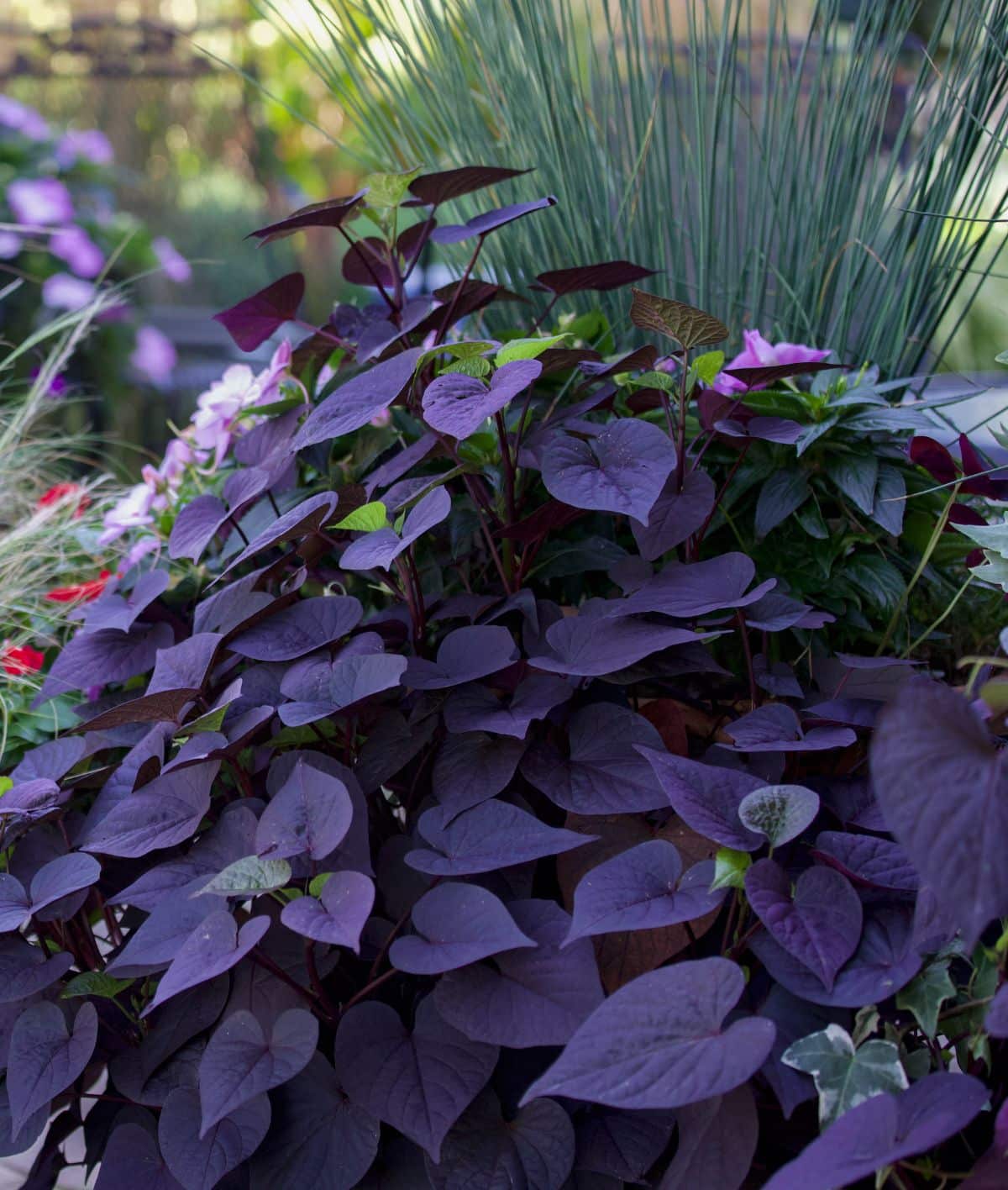
No. While there are a number of flowers that appear black, in reality, flower petals are actually very dark, muted tones of crimson, purple, green, or brown. Some species that feature dark, nearly black flowers include roses, irises, and hellebores.
While plants may not actually be black in color, there are many plants that are so dark that they appear black in most lighting. Some examples of plants with very dark leaves and stems include purple plum trees, ‘Diabolo’ ninebark, and black mondo grass.
No. Roses come in many different colors, including dark reds and purples, but truly black roses don’t exist in nature. To achieve this striking look, florists may dye roses black or spray paint them, but the black tones are not natural.
There are a variety of darkly colored lilies that may appear black in certain lighting. Some examples include ‘Black Star’ Zantedeschia and ‘Black Pearl’ Asiatic lily.
Plant petals don’t naturally produce black pigments, so truly, black flowers don’t exist in nature. That said, many plant flowers are so dark that they absorb most of the light that hits them and appear black to the naked eye.
If you’re designing a garden to accentuate your Gothic Victorian home, try out some classically dark flowers, like ‘Onyx Odyssey’ hellebores, ‘Black Baccara’ roses, and ‘Black Beauty’ pansies.
Summary
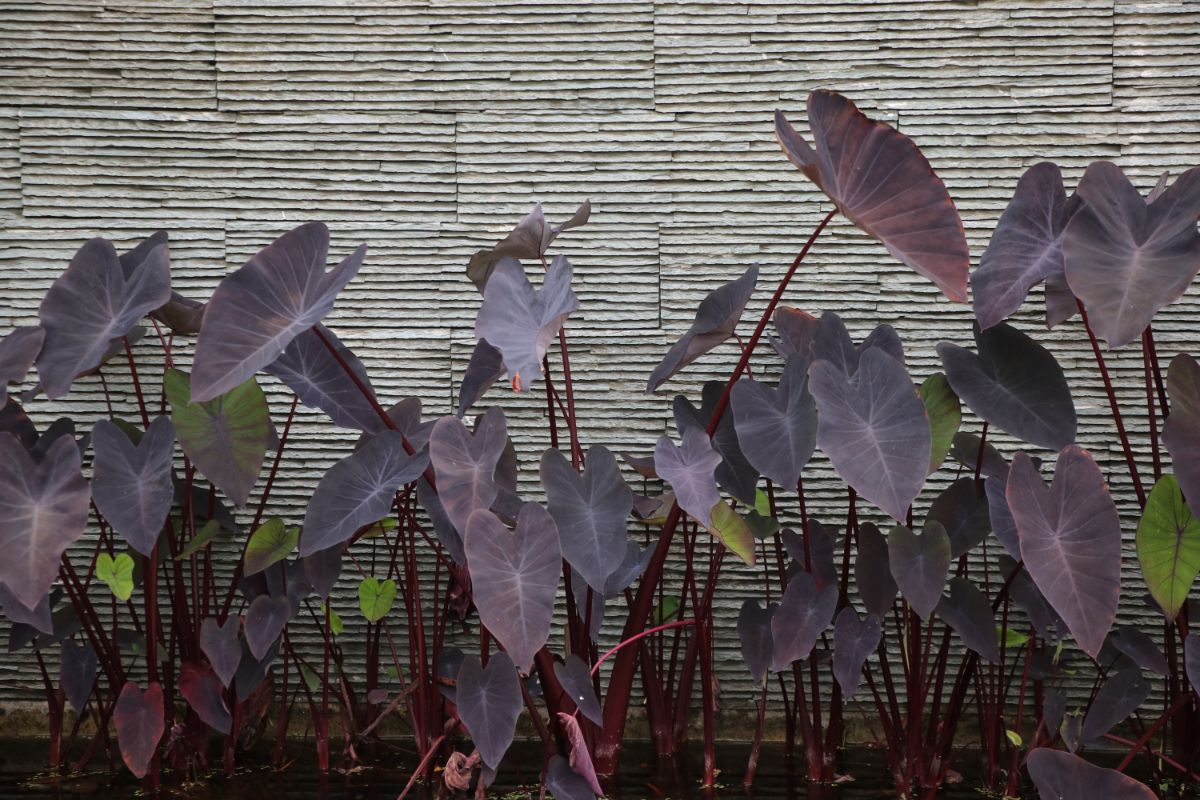
Dark plants and flowers are unexpected additions to garden beds, but they can be just as pretty as pastel blooms. Remarkable in their uniqueness, dark blooms can add elegance and intrigue to any outdoor space.
Sown singly in planters or together in coordinated drifts, dark blooms can be paired with colorful plants for contrast, or you can create an entire design around the deepest, midnight petals. No matter your style and garden design, try out some of the plants we’ve covered today and be wowed by their rich tones and dramatic look!
If you like the idea of color-coordinated garden beds but dark flowers aren’t for you, try out some more colorful blooms with this guide on the best orange perennials to grow in your garden.


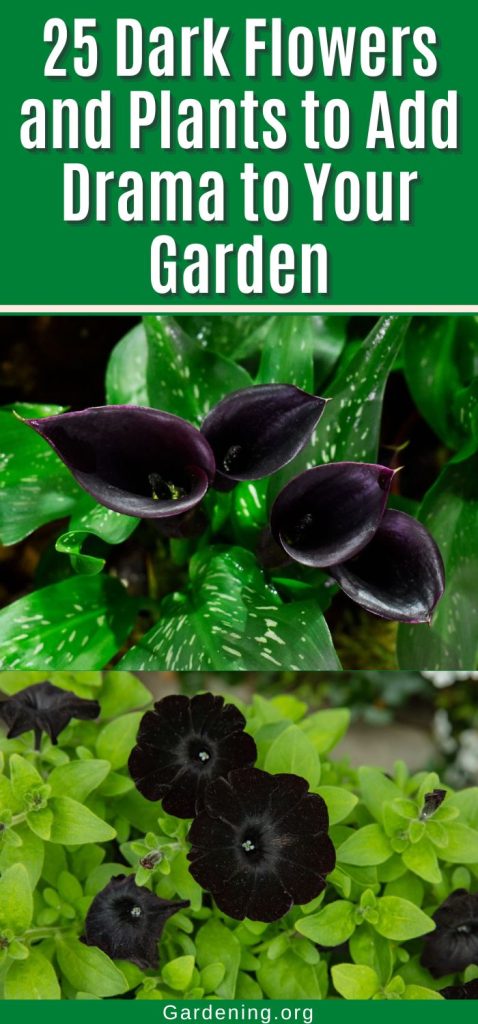
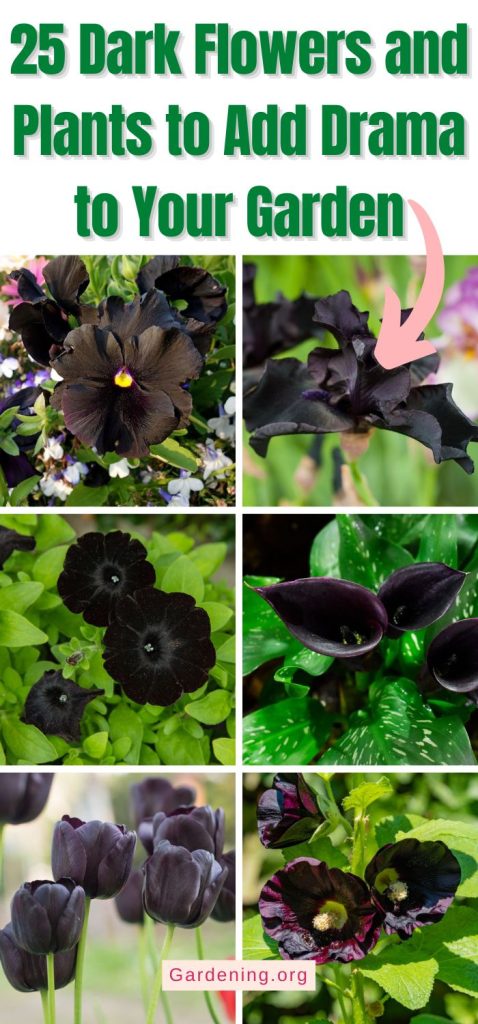

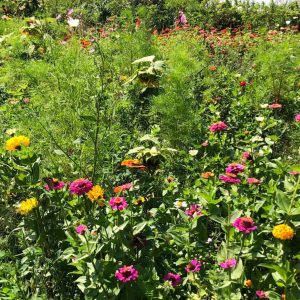
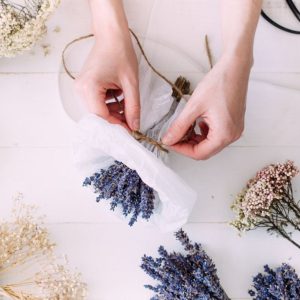
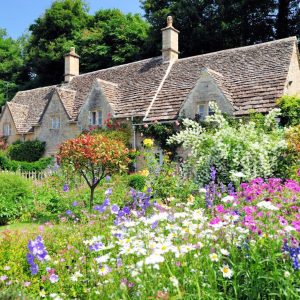
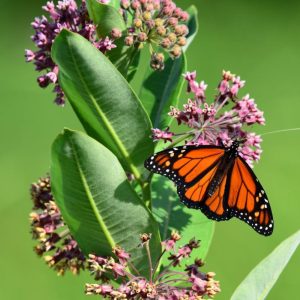
NDN
Absolutely beautiful and the most fun shopping for these exotic varieties. Complement with pure white impatiensand it's magic
NDN
Absolutely beautiful and the most fun shopping for these exotic varieties. Complement with pure white impatiens and it's magic!
Mary Ward
Yes I can see how that would be a stunning contrast!